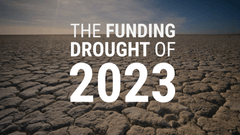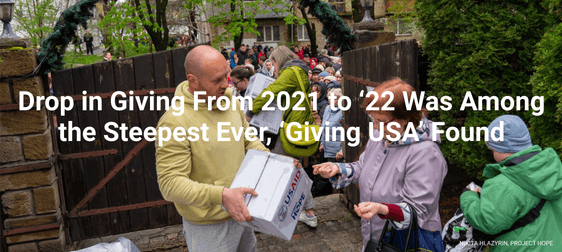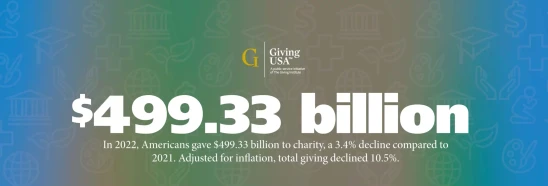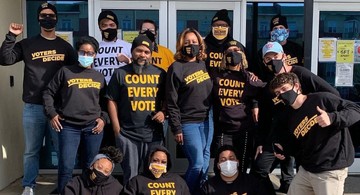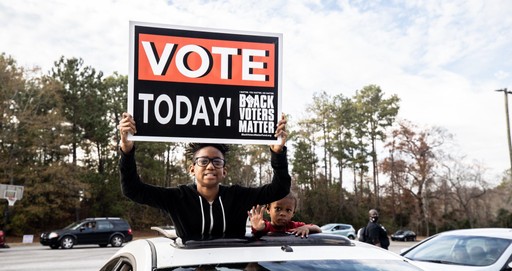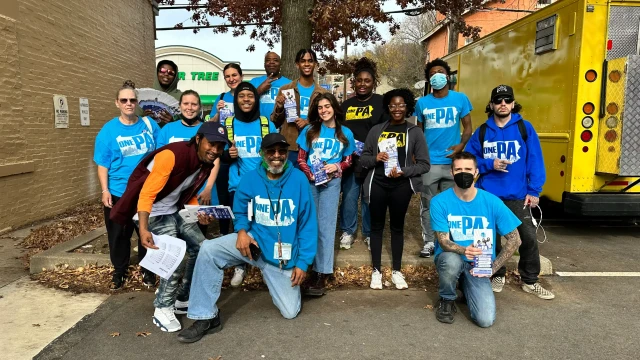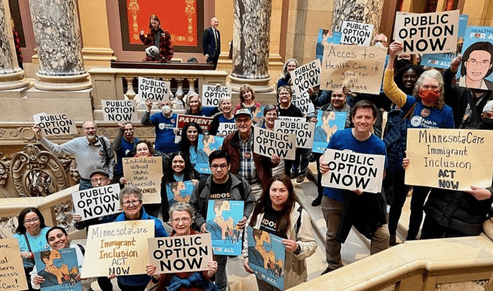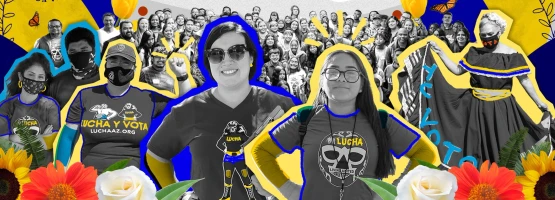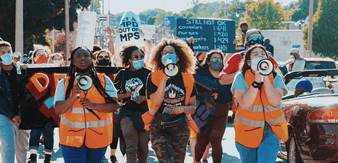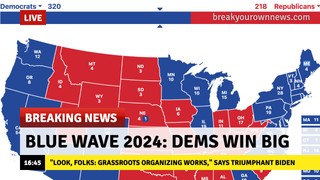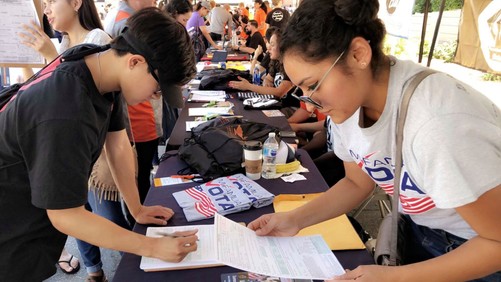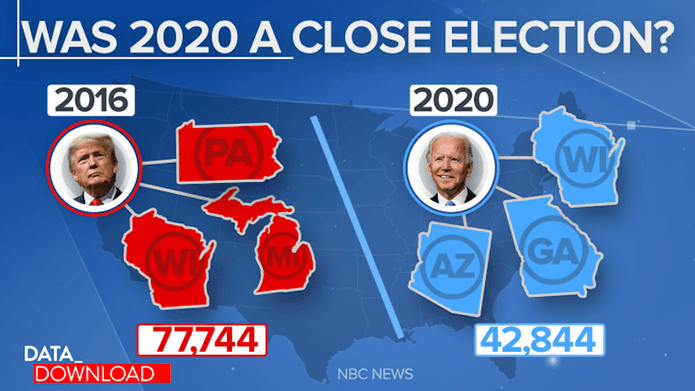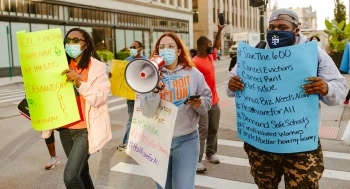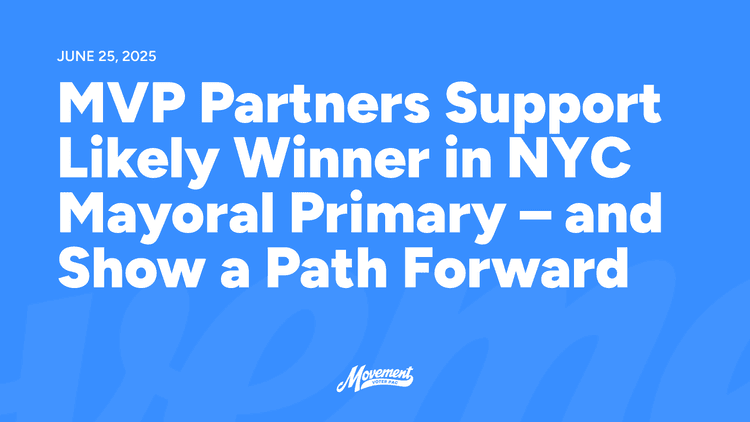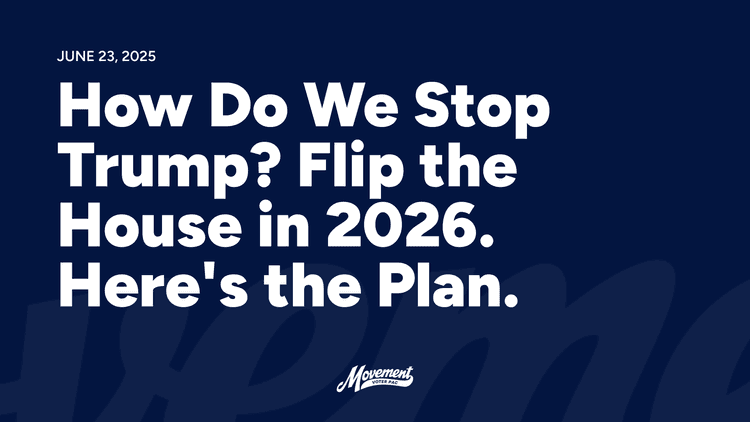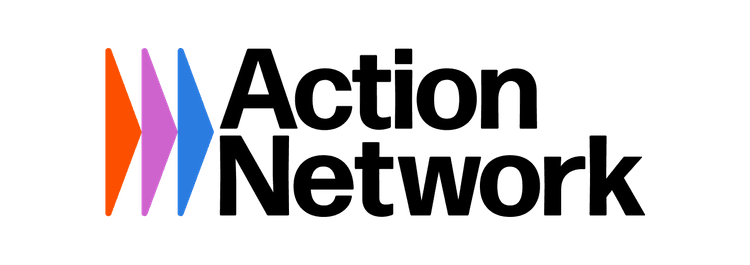Sending Up the Bat Signal

Original Image Credit: 1950s Unlimited on Flickr. Creative Commons 2.0.
Notes
- Donate: Make a contribution here.
- PDFs: Here are the Full Memo & Executive Summary for download.
- Short Version: Prefer the version that’s 1/3 as long? View the abridged piece.
- Press Inquiries: Contact us to discuss this piece with Billy Wimsatt, our Executive Director.
- Press Clips & Resources: Jump below for press clips and ways to spread the word.
Dear Colleagues in Progressive Philanthropy:
I’m officially sending up the Bat Signal and pressing the panic button. The bad news: We have a five-alarm fire going into 2024. The good news: We can save the country and usher in a new Progressive Era.
There are two things I’m worried about – and I also see a giant glimmer of hope. The first thing I’m worried about should be obvious. A little over a year from now, the fate of our country, democracy, climate, and our kids’ futures will likely be determined by a few thousand votes in a handful of states. On November 5th, 2024 at 11pm ET, we will all be anxiously hitting “refresh” as votes are tallied and translated into red and blue maps that will determine our destiny. We’ll have a lot of questions on our minds that night, which boil down to one big question: Will the next four years be a nightmare?
The second thing I’m worried about: Donations to progressive organizations are way down in 2023 across the board. In the 2019-2020 election cycle (and to some extent in 2021-2022), donors gave like our lives depended on it. This has not happened yet in the 2023-2024 election cycle. As a result, progressive electoral groups are struggling financially, and the problem appears to be getting worse. Obviously, these two problems are interconnected: Groups need money to make sure we have a good outcome next November. But. People. Are. Not. Donating.
Extended donor inaction is creating a movement-wide crisis – the drought before the wildfire. I want to make sure everyone is 100% clear on what is happening and the choices in front of us. Let this be an invitation to roll up your sleeves (or at least pick up the phone to call your financial advisor), make the most ambitious giving plan you can, and be part of the solution! This is an open letter to progressive donors – large and small – to collectively address this funding drought, before it becomes a Canada-sized wildfire that burns down our progressive organizing infrastructure in advance of 2024.
What is the giant glimmer of hope? Read on.
Let us know what you think!
Billy Wimsatt
Executive Director, Movement Voter PAC
Table of Contents
- Executive Summary
- ACT I: The Funding Drought
- ACT II: We Have Already Won SO Much
- ACT III: Why It All Comes Down to 2024
- ACT IV: The Future We Can Choose
- ACT V: What Do We Do Now?
- Closing: Let’s Win the Amazing Scenario!
Executive Summary
Read time: 5 minutes
Key Points
🚨 Progressive giving has dropped and we risk a MAGA takeover in 2024.
🤩 We’ve won so much since 2020. We can’t give up now.
⏰ 2024 will be razor-close, and shape our future for generations to come.
🤯 Local organizing is key, since elections are won by who votes vs. who runs.
💸 What do we do? Give big and give early to grassroots voter organizing.
ACT I: The Funding Drought
- A Movement-Wide Crisis: 2022 saw an historic drop in US charitable giving, which has continued in 2023 across the progressive movement. If we don’t address this soon, we risk dangerously weakened infrastructure going into 2024.
- What Would it Take to Stem the Drought? $100-300 million, deployed strategically to grassroots local voter groups for the rest of 2023, would strengthen our position in 2024.
- The. Money. Is. There. If this sounds like a lot of money, it is. But every two years, liberal donors give more than $500 billion to charity — over 100 times what goes to the entire field of progressive voter organizing and engagement.
ACT II: We Have Already Won SO Much
- 2016-2020: The Big Comeback: Trump’s 2016 election was a wakeup call like no other. In 2018, we flipped the House, won eight governorships, flipped six state chambers, and picked up over 300 state legislative seats. In 2020, we beat Trump and gained a trifecta.
- 2021-2023: We Defied the Odds + Delivered Results: In 2021-2022, we passed billions for clean energy and cut child poverty in half. In 2022, we picked up a Senate seat, came just shy of holding the House, and won a state-level Blue Wave. Local organizers swung the closest elections, and have won progress that was out of reach just a few years ago.
- Organizers: The “Essential Workers” of Democracy: We could not have won all of this without the work of over 1,000 largely invisible progressive and community organizations. These groups operate under the radar, but collectively engage tens of millions of voters.
- We’re Halfway There! By the early 2030s, progressive and diverse younger generations will make up a majority of the electorate, with voters of color growing in power. If we invest in organizing these voting blocs over the next five election cycles, we can gain an electoral lock on the Presidency and win durable majorities in the Senate and House.
ACT III: Why It All Comes Down to 2024
- What’s at stake: Due to the climate crisis, geopolitical megatrends, and tough Senate odds in 2026-2030, the 2024 elections will determine a lot about the future of every living person and generations to come. There are four scenarios we face in 2024:
- Worst Case Scenario: MAGA Trifecta: MAGA Republicans win a trifecta; expand the power of the Executive Branch; dismantle climate protections; launch an escalated assault on democracy; and incite violence against our most vulnerable communities.
- Next Worst Scenario: MAGA Gridlock: Biden wins, but Democrats lose the Senate and/or House. A MAGA Congress will force austerity and make it nearly impossible for Biden to do anything. The Senate map is so structurally biased that if Democrats lose the Senate in 2024, we are unlikely to win it back for multiple cycles, perhaps a decade or more.
- Mediocre Scenario: Timid Trifecta: We elect Biden and hold the narrowest possible trifecta, in which a single Democrat in Congress could derail progress. One of the worst things about this scenario? The lack of results could prompt Democratic voters and donors to sit it out in 2026, enabling the GOP to sweep a heavily-favored Senate map.
- Amazing Scenario: We win the Presidency and a governing majority in Congress to pass transformative legislation, from voting rights to abortion rights and climate renewal. This would be an enormous leap forward — potentially the biggest in our lifetimes.
ACT IV: The Future We Can Choose
- Sand Castles vs. Power that Lasts: Grassroots groups are our greatest hope in any scenario. Why? Elections are mainly won based on who votes, not who runs — plus, election campaigns end, but local organizing doesn’t (if we fund it). These groups are our best defense against authoritarianism; a catalyst for state progress in case of federal gridlock; and necessary pressure for good bills if we have the votes.
- Freakishly Small Margins = Historic Opportunity: A small number of votes likely separates the Amazing Scenario from the other scenarios. Due to this, we will decide, based on our enthusiasm (and the time and money we invest), which scenario we get.
- Joe Biden Is Not Going To Save Us: If Democratic turnout dips even a little bit due to lessened enthusiasm, we could lose. This is why trusted local organizations are going to be all-important in 2024: to give millions of sporadic and skeptical Democratic-leaning voters a reason to vote, when candidates do not.
- What is the Antidote to Donor Inaction? Whether or not we identify as “political,” we all have people, places, and communities we care about. The antidote to inaction is to realize that the 2024 elections are our best chance to protect what matters most to us.
ACT V: What Do We Do Now?
- Step 1: Give Big. Ask yourself: What can I give, so that I wake up the morning after the 2024 election with no regrets?
- Step 2: Give Early. Simply giving earlier will make your money go a lot farther. When we give early, grassroots groups are able to scale and upgrade their operations for a bigger impact. The 50-25-25 Strategy is a bold yet simple plan that takes away the guesswork:
- Set your 2023-2024 giving budget to support grassroots organizing. Dig deep. Then dig deeper. Identify the stretch you’d be proud to make.
- By end of 2023: Give 50% of your budget, as early as possible.
- By March 2024: Give the next 25%.
- By July 2024: Give the final 25%.
- Step 3: Rally Your Network. Extensive research shows that person-to-person “relational” outreach moves people to action. What if donors organized other donors, so swing-state organizers had the funding to focus on organizing voters? Each of us is a trusted messenger to someone. To whom are you a trusted messenger?
CLOSING: Let’s Win the Amazing Scenario!
- We Are the Ones We’ve Been Waiting For: The future of the world and everything we love depends on us. If we choose the Amazing Scenario, we will have a much better country in two to four years. If we choose the Mediocre Scenario, we could have a much better country in 10-12 years. If we choose the other two scenarios (through our inaction), we may regret it for the rest of our lives.
- 2024 Opens the Door: If we stay committed over the next few election cycles, we can create a new normal where we reliably win federal elections by multiple percentage points, enact policies that reflect our values, and rebuild our country with a more sustainable and inclusive vision. We can create a legacy we are proud of on this Earth – for our children and children’s children. There truly is no time to waste.
Photo by Oleksandr Sushko on Unsplash
ACT I: The Funding Drought
A few weeks ago, I got off the phone with an Executive Director from a well-respected organization in a battleground state. The organization, which has a very strong track record, had hit an unexpected funding shortfall, and was in danger of having to lay off its entire staff in the coming month unless they raised over a hundred thousand dollars.
This is one of more than a dozen calls I’ve gotten in recent weeks from leaders describing desperate financial situations: painful layoffs, tapping reserves, cutting impactful programs, Executive Directors going without pay or needing to step away from the work entirely, due to extreme stress.
Chronicle of Philanthropy, June 2023
A Movement-Wide Crisis
2022 saw an historic drop in US charitable giving — 10.5% after inflation — and it appears to have continued in 2023, especially for political organizations.
An especially concerning indicator: The Movement Cooperative (TMC) just put out a memo with anonymized stats on financially-driven cutbacks of its member groups. TMC, a backbone institution for the entire progressive ecosystem that provides more than 1,000 organizations with data infrastructure, support staff, and tech tools including access to the voter file, is itself facing a multi-million dollar shortfall.
These aren’t isolated anecdotes. There is a growing chorus of data points that this is happening across the progressive movement, even for groups working on hot-button issues like LGBTQ rights and reproductive justice, whose constituencies are suffering high-profile attacks in the news every day.
You would think these groups would be receiving bucket-loads of money right now. They’re not. Not even in the most hotly-contested battleground states like Arizona. Equality Arizona, Arizona’s major statewide LGBTQ organization, had ten paid staff as recently as 2022. They worked hard and defeated a scourge of 22 anti-LGBTQ bills. But money didn’t come. So they had to lay off their entire staff. Their Executive Director is now an unpaid volunteer.
We are hearing similar stories from other battleground states like Georgia, Michigan, and Pennsylvania, where at least one major organization will have to pull the plug on its door-to-door canvas this month, right before the major state Supreme Court election this fall.
The funding drought is not just affecting local organizations. It was recently reported by Blue Tent that several prominent national organizations including Sierra Club, Color of Change, Planned Parenthood, Arabella Advisors, ActBlue, and Movement Voter PAC (where I serve as Executive Director) have recently had major layoffs as well.
In MVP’s case, I had to make a hard choice to lay off more than a dozen staff, freeze expenses, postpone our team retreat, and lower financial projections for 2023-2024. As one of the largest funders of grassroots local electoral organizing, we are worried that MVP taking a hit will have ripple effects across the field.
As painful as MVP’s layoffs have been, MVP is doing relatively decently under the circumstances. Our team has pulled together in an impressive way, and there are signs we are coming out of this stronger. Comparing notes with colleagues in the field, MVP has been lucky.
Most organizations don’t want to talk openly about financial struggles because we associate them with failure and shame. We worry that talking about them will cause donors to view us in a negative light. What did we do wrong? Will our donors, staff, and boards think that we are not good at our jobs?
A lot of organizational leaders are experiencing a sense of failure, isolation, self-judgment, and fear right now. And it’s much harder on BIPOC (Black, Indigenous, People of Color) leaders and staff from marginalized backgrounds, who already have to swim upstream to prove themselves within the racist and sexist cultures of politics and philanthropy.
I wish I had sent out this Bat Signal months ago – so many organizations are in critical condition. But better late than never. We have a responsibility to break the silence and sound the alarm.
What Would it Take to Stem the Drought?
The last three years since the pandemic have been tough on organizations. It has been character-building, to say the least. As a field, in many ways, it feels like we are coming out of this period stronger, wiser, and more resilient.
In the big picture, organizational change is part of an evolutionary process – forests need occasional forest fires to make way for new green shoots. What doesn’t kill us makes us stronger (sometimes).
But the funding shortfall of 2023 is different – it’s the movement equivalent of an extended nationwide drought. If we don’t get some rain soon, I am worried we could have a massive, Canada-sized wildfire burn through the progressive political and organizing sector over the next few months, leaving us with dangerously weakened infrastructure going into the 2024 elections.
Going into a big election year, we need organizations to have confidence in their financial position and a healthy sense of stability from which to respond to crises and opportunities, and to do their best work. Instead, I am hearing fear, desperation, and resignation.
When money is scarce, it can catalyze a whole range of cascading issues – from reduced programmatic work to stress on individuals and teams. Financial scarcity, like poverty, can impact organizations in deep ways that can cause lasting damage.
Yes, adversity can make us stronger. But only to a point. Too much adversity for too long can wear down even the strongest leaders and relationships.
2023 should have been a “capacity building” year: Staffing up, scaling up, leveling up the infrastructure. Instead, it has become a “tighten your belt to survive” year. We can’t afford to let the whole forest burn down right before 2024.
How much money would stem the drought? $100-300 million, deployed strategically to grassroots voter engagement groups for the remainder of 2023, would go a long way.
Regardless of your giving capacity, remember: These elections will be won on razor-thin margins, so every dollar could lead to the tipping point vote.
The. Money. Is. There.
If that sounds like a lot of money, it is. But to put things in perspective, in the 2020 election cycle the Democratic side spent over $7 billion, so $100-$300 million is not out of proportion with what is already being spent (most of it goes to TV ads). And that’s just hard political money – which is nothing compared to what Americans give in tax-deductible donations.
Giving USA 2023
Every year, Americans donate $500 billion to charity. Given that Biden-voting counties make up 71% of U.S. GDP, we can assume at least half of that $500 billion comes from people who vote for Democrats. So every two years, Democratic-leaning donors give more than $500 billion to charity — over 100 times what is given to the entire field of local organizing, progressive advocacy, and voter engagement (i.e. the most cost-effective way to fund lasting progress).
The. Money. Is. There.
If Democratic-leaning donors shifted 1-2% of their existing charitable donations, the field would have $5-10 billion a cycle. If we could only educate and organize Democratic-leaning donors to donate more strategically, we could solve so many societal problems “upstream.”
The bat signal doesn’t mean hope is lost. It means help is needed. I know we’re up for this challenge, because we’ve accomplished so much together already. We can do this!
ACT II: We Have Already Won SO Much
A big part of donor fatigue is a sense of not knowing whether all the work we are funding is actually adding up to anything.
It is so important to remind ourselves of what we have achieved and how far we have come.
New Georgia Project Action Fund
2016-2020: The Big Comeback
Trump’s election in 2016 was a wakeup call like no other. In 2017, we won every special election, flipping the Virginia House of Delegates, and winning a Senate seat in Alabama. In 2018, we flipped the House (which we were told at the time was virtually impossible because of gerrymandering), won eight contested governorships, flipped six state chambers, and picked up more than 300 state legislative seats.
In 2020, we went all out. Our massive investments of time, money, and community-based grassroots organizing paid off. Trump got more votes than any presidential candidate had before, but our side had even more unprecedented turnout. And we won. We won in spite of voter suppression and the Electoral College’s Republican bias — and behind the scenes, grassroots organizations protected the election against Trump’s lies and an inflamed MAGA base bent on nullifying the results. Incumbent authoritarian regimes are difficult to beat, and we did it anyway.
Black Voters Matter, getting out the vote for the 2021 Georgia Runoff
Right after we defeated Trump, we did something even more improbable: On January 5th, 2021, we won a double Senate runoff in Georgia – back when Democrats never won Georgia runoffs – securing a federal trifecta (which we never got to properly celebrate because the very next day was January 6th). What a magnificent and hard-fought victory that was! (See MVP’s 2020 report.) Few knew that our Georgia partners had been organizing for years to turn the state purple.
We also elected the most diverse and progressive Democratic Congress ever. The Progressive Caucus, which was practically a non-entity as recently as six years ago, is now the largest caucus in Congress.
Because of these victories — and because we as a movement have shifted the center of gravity on so many issues, from climate to economic justice — we were able to pass hundreds of billions of dollars for clean energy and trillions in family-supporting policies that cut child poverty in half.
The Biden administration even tried to cancel $400 billion in student debt, an idea that grew out of Occupy Wall Street and was unimaginable just ten years ago. They also appointed thousands of reasonable adults to run the federal government, confirmed a record number of judges (including more Black women appointed to circuit courts than all past presidents combined), and passed hundreds of helpful policies from gun safety to LGBTQ equality (see highlights).
Biden is not perfect and no one is swooning over him, but just three years in, his administration has shown what happens when we start to stack electoral power with grassroots power: We get some of the boldest policy changes in decades.
This is all because of the work we have done as a movement. We elected two ordinary Democrats, Biden and Harris. We elected Democratic majorities in Congress. We gave them a two-year trifecta. We built progressive power. We shifted public opinion. We pushed them to deliver. And to a surprising degree, they have exceeded expectations. This largely came about thanks to the sustained year-round work of hundreds of local community-based organizations, strategically building long-term political power from the ground up.
One PA – 2022 Get Out the Vote push
2021-2023: We Defied the Odds + Delivered Results
2022 was supposed to be a Red Wave. But we defied the odds, picked up a seat in the Senate, came 6,675 votes shy of holding the House, and won a state Blue Wave. For inspiration, read the “Top 25 Close Elections We Helped Win” section of MVP’s 2022 report.
At the state and local levels, everywhere we have invested deeply and consistently, organizers have achieved victories that seemed out of reach a few years ago, from 100% clean energy plans to voting rights, gun safety, and more.
We flipped Arizona and Georgia blue, delivering all four of their U.S. Senate seats to Democrats. We gave Arizona a Democratic Governor, Secretary of State, and Attorney General, and we’re now just two seats away from flipping both of its state chambers.
Unidos MN, who helped win expansion of Minnesota’s state-funded health insurance program
Michigan, Minnesota, and Maine won Democratic trifectas that they quickly put to work for working people. Wisconsin turned a major corner this year and flipped control of their State Supreme Court. They might even re-legalize abortion and have fair maps in time for 2024.
Down ballot, we’ve made huge progress – from electing dozens of reform-oriented District Attorneys in major counties to electing historic numbers of women, people of color, and LGBTQ leaders across the country. (Research has also shown the “reverse coattails” effect, in which inspiring down-ballot Democrats have helped drive turnout for the whole ticket.) We helped expand Medicaid to 600,000 North Carolinians. And MVP partners have won a long list of ballot measures – from abortion rights to voting rights, direct democracy, and criminal justice reform, even in red states like Kansas and Kentucky.
The progress we have made over the past few cycles is contributing to major positive trends in our society. We’re in the early stages of mass decarceration (with almost 20% fewer Americans incarcerated than in 2009) and mass decarbonization (US emissions are down about 20% from 2005); we’re seeing the lowest unemployment in 50 years (with wage growth outperforming inflation), and so much more.
Credit: Living United for Change in Arizona (LUCHA)
Organizers: The “Essential Workers” of Democracy
We wouldn’t have won all this without 1,000+ local, largely unsung progressive and community organizations – and the donors who support them.
These organizations are the “essential workers” and “first responders” of our democracy: Day after day, local organizers fight injustice, heal the wounds of our communities, and patiently plant the seeds and till the soil of voter turnout.
These groups operate independently, humbly, under the radar. Very few are even known outside of their local communities. But collectively they work with tens of thousands of organizers to organize their communities year-round, and engage tens of millions of voters.
In short: organizing works. Investing consistently in long-term local organizing has returned enormous dividends. The fruits are all around us!
It is tempting to think our gains made since 2016 were a foregone conclusion. But none of this “just happened.” We got here because donors donated and organizers organized – and in many cases donors organized and organizers donated. We did all the things.
Remember that anxiety we felt in 2020, facing down the prospect of a Trump second term? We avoided that potential future (and flipped the Senate) because a passionate, prepared, well-funded ground force of local voter groups had the resources to organize in every competitive state, until the last vote was cast and counted.
Leaders Igniting Transformation (LIT)
We’re Halfway There!
We have come so far. This is not the time to let up. If we double down, ten years from now we could have a much better country – or even two years from now.
It’s not too late for us as Americans – or as a human species. It takes years to move mountains. This is not the time to get discouraged. If we keep focused, keep the faith, and keep chipping away, cycle after cycle, we can carry our beloved country into a much better place.
We’re halfway there!
It has been 13 years since the rise of the Tea Party movement, and 8 years since the rise of Trump. If we play our cards right over the next 7-10 years, and invest in a strategic and disciplined way, by 2033 we will enter a new Progressive Era.
By the early 2030s, fossil fuels will be on their way out. The green economy is multiplying. The super-progressive and diverse younger generations (Millennials, Gen Z, and the beginning of Generation Alpha!) will make up a majority of the electorate, with voters of color growing in power. If we invest in organizing these voting blocs over the next five election cycles, we can win all four Senate seats in Texas and North Carolina by 2032, cementing a durable Senate majority.
We can mitigate a lot of the worst gerrymandering by either 2025 or 2031 (see our 2024 plan). We can grow a Democratic Supermajority in the House. We can gain an “electoral lock” on the Presidency. If we can hold the Presidency and Senate, we can steadily relegate the GOP to minority status within the judiciary (including the Supreme Court). And we can win Blue Trifectas in close to 30 states, representing at least 70% of the US population (see below).
The single biggest factor in our success over the next ten years? How well we perform in 2024.
ACT III: Why It All Comes Down to 2024
Let’s look at what is at stake between now and November 2024. Due to the climate crisis, geopolitical megatrends, and tough Senate odds in 2026-2030, the outcomes of the 2024 elections will determine a lot about the future of every living person and generations to come.
On one side, we have a center-left party. On the other, we have an extremist, authoritarian party hell-bent on denying climate science, election results, reproductive rights, racism, and LGBTQ+ rights. There are four potential scenarios we face.
The Worst Case Scenario: MAGA Trifecta
I know it’s hard to imagine Trump could be President again. But it was hard to imagine the first time, too. We underestimate him and the MAGA Republican base at our peril.
Biden and Trump are statistically tied in the polls, and are likely to stay tied no matter the outcome of his multiple criminal proceedings.
If 2024 Goes Badly, It’s Going to Go Really Badly
At this point, the country is so polarized that Republicans could put up a ham sandwich and still get 49% of the vote in the Electoral College swing states. An unexpectedly strong wind (or October surprise) could push them over the finish line.
And if Trump wins, he’ll likely win it all. FiveThirtyEight hasn’t come out with its models yet, but I can tell you what they are going to say: Under the scenario of Trump winning, a Democratic House or Senate is unlikely, because of correlated voting patterns.
If Trump gets his MAGA trifecta, all bets are off.
Authoritarianism and Political Violence
A silver lining of Trump’s first term was that his team was disorganized and unprepared to hold office. This time, an alliance of 70 right-wing organizations is already creating a blueprint called Project 2025, to enact an autocratic governing plan for Trump’s first 180 days.
Project 2025 would enable Trump to rapidly seize unprecedented power over the Executive Branch, dismantle climate protections, rip the floor out from underneath our democratic way of life, punish political enemies, and more.
Trump’s assault on media and democratic institutions, his instigating of political violence, and his scapegoating of racially, religiously, and sexually marginalized communities are all documented steps on the path to autocracy and, yes, fascism.
Imagine you are reading the following about a dictator in a foreign country:
- His public rhetoric drove a surge in violent hate crimes against racial and sexual minorities.
- He has conducted a decade-long attack on democracy and emboldened a movement of vote-suppressors and election deniers.
- He knowingly sent armed supporters to the Capitol on January 6, and has incited a terror campaign against election workers that continues to this day.
- He has helped usher in a new era of normalized right-wing support for political violence — “kindling” that could catch fire and cause chaos and civil breakdown, especially with four trials looming before the 2024 election.
Trump has already shown he can inspire violence when defeated. If he wins in 2024, what would stop him from expanding his executive powers (as promised) and even more overtly inciting violence against immigrants, LGBTQ+ people, communities of color, and anyone who dares speak up against him?
This is truly scary stuff. We can’t afford to treat this as just another election.
Black Voters Matter
Grassroots Organizing: Our Insurance Policy
So much can go wrong between now and November 2024.
Between the unknowns like Biden’s age and health, low enthusiasm, No Labels, Cornel West running on the Green Party ticket, climate chaos, global volatility, and dicey economic conditions, there are way too many factors outside our control to go into 2024 with anything other than extreme concern.
We pray that the Worst Case Scenario doesn’t come to pass. But we would be foolish to assume it’s any less than a 50-50 proposition.
If you knew you had a 50-50 chance of your house burning down in the near future, wouldn’t you buy the best homeowner’s insurance you could?
In essence, funding grassroots organizing in the key battleground states is like buying the best insurance policy we can afford, to protect ourselves from this scenario.
The Next Worst Scenario: MAGA Gridlock
The next worst scenario is that Biden squeaks through the Presidential race (with another violently-contested election aftermath), but we fail to flip the House, and/or Democrats lose the Senate by losing any two of the following: Ohio, Montana, West Virginia, Nevada, Michigan, Pennsylvania, Wisconsin, or Arizona.
In this scenario, the country will be ungovernable on a level not seen in our lifetimes. A MAGA Congress will use its power to launch investigations, shut down the government to force austerity, and make it nearly impossible for a Democratic President to do anything.
We will lose precious years to address the climate crisis. Democrats won’t even be able to appoint judges, cabinet members, or military and national security leaders, let alone Supreme Court nominees. Nothing good will happen at the federal level for at least the next four years.
The 2026 midterms are unlikely to bring relief. The Senate map is so structurally biased that if Democrats lose Senate control in 2024, it will take multiple cycles to win it back.
The Mediocre Scenario: A Toothless Trifecta
If the first two scenarios are about grave danger and dismay respectively, the Mediocre Scenario is all about relief that quickly turns to disappointment.
In this scenario, we elect Biden, hold onto a 50-50 Senate by our fingernails (holding Ohio, Montana, Arizona, and the others, losing only West Virginia), and win the narrowest possible majority in the House.
The situation would be most akin to the 2021-2022 legislative session in which Democrats nominally had a trifecta, but their ability to govern and pass major legislation was severely constrained, with a single conservative Democrat in the House or Senate able to hold the process hostage.
One of the worst things about this scenario? The lack of results could prompt Democratic voters and donors to sit it out in 2026, enabling the GOP to sweep a heavily-favored Senate map in pivotal races that include Georgia, North Carolina, and Michigan.
We can already imagine the narrative: “We voted for Democrats. And what did they do? Nothing!”
To be clear, the Mediocre Scenario is still light-years better than the MAGA Gridlock scenario. Democrats would still be allowed to confirm judges and cabinet members. They wouldn’t have to play chicken every year just to pass the budget, or raise the debt ceiling. They might even be able to pass some decent legislation.
And there would at least be the possibility of expanding their majorities in 2026 and getting to the (relatively) Amazing Scenario below.
This is NOT a real headline — but it COULD be on November 5, 2024, if we invest like we mean it.
The Amazing Scenario: Blue Wave + Bold Trifecta
In the Amazing Scenario, we win the Presidency and enough of a governing majority in the Senate and House to pass transformative legislation.
The Amazing Scenario is the one we are dreaming of. It’s the one that is worth fighting for. We have a very narrow path. The Georgia runoffs were a narrow path. Defying the Odds in 2022 was a narrow path. The Amazing Scenario is a narrow path – but possible.
In this scenario, we strategically deploy funding at or above 2020 levels like our lives depend on it. We fund and fortify the best groups who turn out youth, voters of color, LGBTQ+, and other neglected and disaffected voters. We win the Presidency, the House, and ALL the Senate seats: Pennsylvania, Wisconsin, Michigan, Nevada, Ohio, Montana – and Arizona, where we replace obstructionist Kyrsten Sinema with the progressive Ruben Gallego. Then, after we win, we lean on everyone we just elected to reform the filibuster and pass all this amazing legislation.
What We Could Finally Win
If we somehow manage to pull the Amazing Scenario off, in 2025, we could win transformational legislation on:
- Climate and clean energy;
- Protecting voting rights and ending partisan gerrymandering;
- Codifying abortion rights and expanding healthcare access;
- Limiting money in politics;
- Free community college;
- Common sense gun laws;
- Progressive taxation;
- Criminal justice reform, and so much more.
The difference between the Mediocre Scenario and the Amazing Scenario is in some ways a matter of degree. If we win a trifecta, the question is: How much good legislation can we pass? How many judges can we appoint?
Winning a Democratic trifecta, even with just 50 Senate seats, would give us our best chance in years to pass major progressive legislation, for two big reasons: Senators Manchin and Sinema, by far the two biggest Democratic stumbling blocks to passing legislation in 2021-2022.
Presumably in any scenario, both will be gone (although if we somehow hang onto Manchin it would actually be helpful, in terms of Senate committee rules, to have 51 instead of 50). But even with just 50 votes, we should be able to do better than we did in the last Congress.
A New Progressive Era
The Amazing Scenario with a transformational trifecta would set us on a path to winning progressive governance over the next decade – at both the federal level and in as many as 28 or 29 blue and purple states that represent 70-75% of the US population.
That means holding all of the 17 current Democratic trifecta states plus picking up 11 or 12 more, including Pennsylvania, Wisconsin, Arizona, Nevada, Virginia, Texas, Georgia, North Carolina, and New Hampshire (all of which have major potential to go triple-blue over the next decade).
We can also do a lot more to “blue-ify” our blue states and make them true leaders toward a more livable future. Here is a mind-blowing example from Minnesota, to remind us what’s possible when we invest in states for the long haul.
The Future Worth Fighting For
The Amazing Scenario in 2024 wouldn’t solve all of our problems – far from it – but it would be an enormous leap forward. Potentially the biggest in our lifetimes.
To put it another way, the Amazing Scenario would be the biggest progressive change we could possibly hope to make right now at this moment in history.
It would be orders of magnitude more amazing than anything else we could possibly invest our time, money, and energy into in the next 14 months. That is why I for one am spending all of my life energy focused on it. (See our MVP 2024 campaign deck — slides 8-9 illustrate the two-year vs. ten year scenario.)
Do a thought experiment and compare The Amazing Scenario to anything else you might put your time, money, and energy into. There is no comparison.
The Amazing Scenario is by far the biggest, best change we could possibly hope to win in the coming year. And it would open the door to fight for thousands more wins in the future.
That is our Giant Glimmer of Hope.
ACT IV: The Future We Can Choose
To review, here are our four scenarios:
- Worst Case: MAGA Trifecta.
- Next Worst: Unprecedented Gridlock.
- Mediocre: Toothless Trifecta.
- Amazing: Blue Wave + Bold Trifecta → Progressive Decade
Like it or not, we will be living in one of these four scenarios very soon. Each scenario is entirely possible; each probably has a 20-50% chance, depending on the day.
Mi Familia Vota – Student Voter Registration Drive
Sand Castles vs. Power that Lasts
Well-funded grassroots organizations are our greatest hope in any scenario.
- MAGA trifecta: Local groups will be our best defense against authoritarianism.
- Federal gridlock: Organizing groups will be our catalyst for state-level progress.
- Toothless trifecta: Vocal grassroots pressure will be essential for passing good bills.
- Bold trifecta: Grassroots organizing will give “political cover” to pass bold policies.
Why?
- Elections are mainly won based on who votes, not who runs.
- Election campaigns end, but local organizing doesn’t (if we fund it).
After Election Night, candidate campaigns end payroll and close up shop… like sandcastles washed away with the tides.
Community organizing groups, on the other hand, recruit locally-based volunteers who are in it for the long haul; deliver year-round, tangible improvements in the lives of their constituents; mobilize the most neglected voters to the ballot box using hyper-local messaging and trusted messengers; and then work to push progress at every level — regardless the election outcome.
As Onah Ossai, Organizing and Base Building Director at PA Stands Up, says:
“If we get you registered to vote and we get you to the polls on Tuesday, we’re gonna be there for you on Wednesday and Thursday and Friday. We’re not just gonna leave. These are issues that still affect us even after the election is over.”
Freakishly Small Margins = Historic Opportunity
The good news and the bad news: A freakishly small number of votes separates the Amazing Scenario from the other scenarios. We have to assume 2024 will come down to mere thousands of votes – or even hundreds.
I want to offer a hypothesis. It might sound hard to believe:
Because the elections will likely be so close, we – progressive donors, organizers, and volunteers – will decide, one way or the other, based on our enthusiasm (and the time and money we invest), which scenario we end up living in.
Hard to believe, yet almost certainly true. We are accustomed to feeling powerless over national affairs. Yet we actually have a lot of power in this situation, much more than we typically assume or take responsibility or accountability for.
Microscopic Margins
To refresh everyone’s memory:
- In 2016, Trump won by less than 78,000 votes.
- In 2020, Biden won by less than 43,000 votes.
- In 2022, Republicans captured the House by 6,675 votes.
- In 2016-2022, Democrats won two Senate races by a total of 10,034 votes (Dems currently have a two-seat Senate majority).
In a country of 340 million, margins this close are unusual in historical terms. How could something so important be determined by such a small, arbitrary group of people?
That so few voters can decide whether one of the most powerful nations in the history of the world remains a liberal democracy or becomes an ethno-nationalist autocracy is… utterly shocking. Almost unbelievable. It makes no sense.
The 2024 Election: A Time-Traveler’s Dream
The idea that our elections would be this close was normalized in 2000, when Bush won by 537 votes in Florida. But zooming out, the past few election cycles have been a total aberration. During the entire 20th Century, major elections were decided by millions of votes, not thousands. A few thousand votes at the margin in a few states didn’t make a difference. Now they do.
The last time we saw anything close to these margins was in the 1800s during Reconstruction, when the electorate was one twentieth the size. The combination of polarization and Electoral College distortion has yielded a deeply unfair system that presents a lopsided opportunity for right-wing forces to seize power and impose minority rule. Or, for us to prevent them – if we recognize the threat/opportunity and capitalize on it.
If you were a time-traveling activist, looking for a time and place where your efforts might be most likely to make the greatest historical-level impact, the United States in the 2024 election cycle would be an incredibly strategic time and place to park your time machine, hop out, roll up your sleeves, and get to work.
Pinch yourself! You happen to be alive in such an extraordinary time and place. And you didn’t even need a time machine to get here.
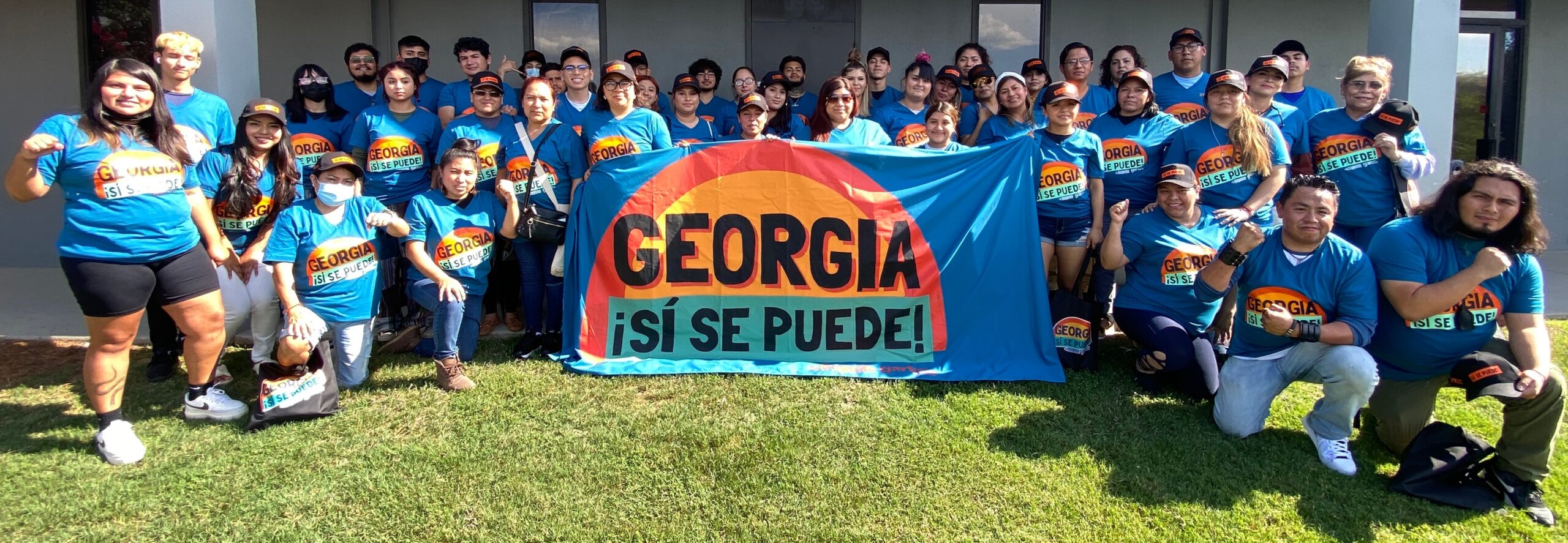
Georgia Latino Alliance for Human Rights (GLAHR) Action Network
Jump Ball for the Future of Humanity
To invoke a metaphor from basketball: the 2024 election is a “jump ball” for the future of humanity. Ethno-Autocracy vs. Multi-Racial Democracy. Fossil Fuel Rule vs. Climate Renewal. Which team will win?
Whichever team puts their money where their mouth is, and brings the most enthusiasm and determination, will control the future. The other team will be left on the sidelines, crying in their drinks.
The fact that control of one of the most powerful nations in the history of the world is up for grabs… and the fact that the decision will be made by a few thousand voters in a handful of states boggles the mind… It is utterly mind-boggling.
Mind-boggling! I’m sorry if I’m repeating myself but I can’t get over it. The fact that such a shockingly small number of people can radically alter the future of the world.
It is quite weird, and it shouldn’t be this way. And yet, we would be fools not to recognize and seize this opportunity and go all hands on deck to win. Clearly the right wing sees this existential threat/opportunity and takes it seriously. We need to make sure we’re not the ones crying on the sidelines at the end of the game.
Joe Biden Is Not Going To Save Us
2024 should be ours to lose. In 2016, Trump lost the popular vote by nearly three million votes. In 2020, he lost by more than seven million. Based on demographic trends, all things being equal, Trump should lose the popular vote in 2024 by more than ten million votes.
But because of the Electoral College, the seven closest states (Georgia, Arizona, Wisconsin, Michigan, Nevada, North Carolina, and Pennsylvania) will likely be decided by less than 1%. And of course, while demographic change is helpful, demographics are not destiny. We have to work hard for every vote. No community or constituency can be taken for granted, nor written off.
If Democratic turnout or performance dips even a teensy weensy little bit due to lessened enthusiasm, or the siren call of third party candidates, we could be totally screwed. Enthusiasm – one way or another – will be the deciding factor.
Obviously, this should spur us to action — like swerving back into your lane when you realize you’re on the wrong side of the road and a truck is coming at you. We know most voters are not showing signs of feeling motivated by either Joe Biden or Kamala Harris. Even if they are the best, most effective, most progressive administration since FDR, few seem to know or care.
That is precisely why trusted local organizations will be all-important in 2024: to fill the inspiration vacuum and give millions of sporadic and skeptical Democratic-leaning voters a reason to vote and the motivation to volunteer (when the candidates do not). And they also do most of the unseen heavy lifting on voter registration, election information, and election protection as well.
A Simple Math Problem?
There are tens of millions of registered, Democratic-leaning voters who may not vote in 2024. This is a fixable problem.
On some level it’s a math problem. It costs hundreds of millions of dollars to pay tens of thousands of staff who train and manage tens of thousands of canvassers and volunteers to talk to tens of millions of voters (which will increase their turnout and/or Democratic performance rates on average by “X” percent), which in turn will yield the margin of victory.
Simple math! But not so simple because there are so many unknown variables in the equation.
We won’t know beforehand exactly how close the margin of victory is going to be, nor in precisely which combination of states. We don’t know what the opposition’s ground game, digital comms, and dirty tricks are going to look like (we have to assume they’ll have some new dirty tricks up their sleeve). We won’t know the impact of third party candidates and how much turnout vs. persuasion we will need to do.
And we can’t predict the precise impact of our voter turnout and persuasion efforts in each scenario (the “X” factor above which varies given the dynamics of each election), and therefore how many additional tens or hundreds of millions of dollars we will need to tip the closest races.
Due to the absolutely bizarre circumstances of our evenly divided electorate, as progressive donors, it is almost unfathomable how much power and responsibility we have to shape the course of US and global history.
What Is the Antidote for Donor Inaction?
So many intelligent, caring, progressive-minded people don’t seem to see this monumental opportunity – and responsibility – staring us in the face.
Whether or not we identify as “political,” we all have people, places, and communities we care about. The antidote to inaction is to realize that the 2024 elections are our best chance to protect what matters most to us.
I think people understand clearly and feel viscerally that the political situation is very important. Sure people will vote, donate, read about it in the papers, watch the returns on election night, maybe even write some postcards, and feel very strongly about it. But by and large, we don’t see it as the sort of thing that we can really do something about.
How many deeply progressive and amazing people are just going about their lives, as if this existential threat / historic opportunity weren’t a thing they could impact?
We have to figure out what it would take to get many more people to see the 2024 election not just as an important cause to “keep in mind as it gets closer,” but as the defining calling of our time – and central thing to focus on and invest our energy, money, heart, and soul into.
A Pivot Point in History
The past ten years and the next ten years are a pivot point in civilizational history. We are locked in an epic struggle over values, power, and whether science and racism are real. We are vying for control of our country.
The declining forces of MAGA are waging a vicious war to turn back the clock on a rapidly diversifying country. Our opponents see this struggle as a second civil war – against us, our ideas, and the communities we love – and they are determined not just to win but to subjugate or bully BIPOC, immigrant, LGBTQ+, and other marginalized communities.
Some progressive donors and activists seem to get this at a bone-deep level – at the level of survival. Many of us have already committed our time and energy and have been donating big and early. Why others don’t see it may be a matter of perspective. It is hard to see our lives and decisions in a larger historical context.
Here’s a provocative thought experiment: Can you imagine, during Hitler’s time, progressive activists and donors talking to each other like: “Oh, that’s a really cool project you’re working on.” Can you imagine, during slavery and the civil war, progressive activists and donors talking about: “Oh what a great organization you’re supporting.”
No! The central question of those times was: What did you do about Hitler? What did you do about slavery? In future generations, people will ask us: What did you do about the climate crisis? What did you do about MAGA?
Sometimes, I think folks on the left are too smart to see what’s right in front of us. It’s too obvious. Too boring. Biden vs. Trump… yawn. Aren’t there more interesting things to focus our energies on? Politics is so overhyped and all-consuming. We’re tired of thinking about it. We are too creative and special and smart to focus our energies on something so banal.
Detroit Action, campaigning against evictions
Elections are Just a Starting Point
To be clear: We are not just doing this to help Democrats beat MAGA Republicans and stop bad things. That alone is not enough. We need bold national policy change, and deeper year-round transformation in states and communities and in people’s lives.
That is why our most strategic path to lasting change is to invest in local organizations that care for their communities year-round, organize issue campaigns, and also do effective local and national electoral work.
The local organizations we support have won hundreds of state and local policy victories that have positively changed tens of millions of people’s lives – in addition to the federal wins that have positively changed hundreds of millions of people’s lives. What we deeply care about is both local and national. We believe in both issues and electoral campaigns. We need to use every tool in the toolbox to win the change we need to see.
No matter your theory of change, there is a lack of urgency to address the drought that is dehydrating our progressive ecosystem. A big part of it is psychological. At a certain point we have to tune out politics to protect our mental health – which is understandable!
But we have to find a way to balance one survival response (the need to psychologically unplug) with another (taking action to save our country). We don’t have to spend too much time thinking about politics. But we do have to do a few important things (like make the biggest donation we can) to make sure we end up in the Amazing Scenario – or at least the Mediocre Scenario.
When we let down our guard and become complacent, like we did in 2010, 2014, and 2016, it is way too easy to end up in a Bad Scenario that could spiral into something even worse.
ACT V: What Do We Do Now?
Thank you for reading this memo.
So where do we go from here? What do we *do* about all this?
I am hoping you will see this Bat Signal up in the sky, put on your superhero cape, and fly to the rescue! We did it before. We can do it again. But our movement is in a drought.
The #1 solution to the problem of dehydrated organizations: Make it rain.
Step 1: Give Big.
The most impactful thing you can do right now is to make a bold giving plan. Period.
Making a giving plan doesn’t need to be complicated. Ask yourself: What can I give, so that I wake up the morning after the 2024 election with no regrets?
Educator, journalist, and MVP supporter Peggy Taylor put it like this in one of our donor briefings:
Close your eyes or lower your gaze for a moment. Imagine the kind of world you most want. Now think about the assets you have in your life. Think about that abundance in your life. And now think about where your assets and your dream for this world most meaningfully connect.
What would be your most meaningful gift at this point? Now imagine what a “stretch” gift would look like. This time matters, perhaps more than any other time in all the years we’ve walked on this planet.
My hope is that you will surprise yourself. That you will choose to dig deep. Dig deeper than you even imagined.
If you’re feeling stuck, think of one friend you can buddy up with. Hop on the phone. Break bread. Make a plan, and support each other to follow through.
Also, feel free to reach out to us at Movement Voter PAC (or your other favorite organizations) to help think through what to do and how to make it happen.
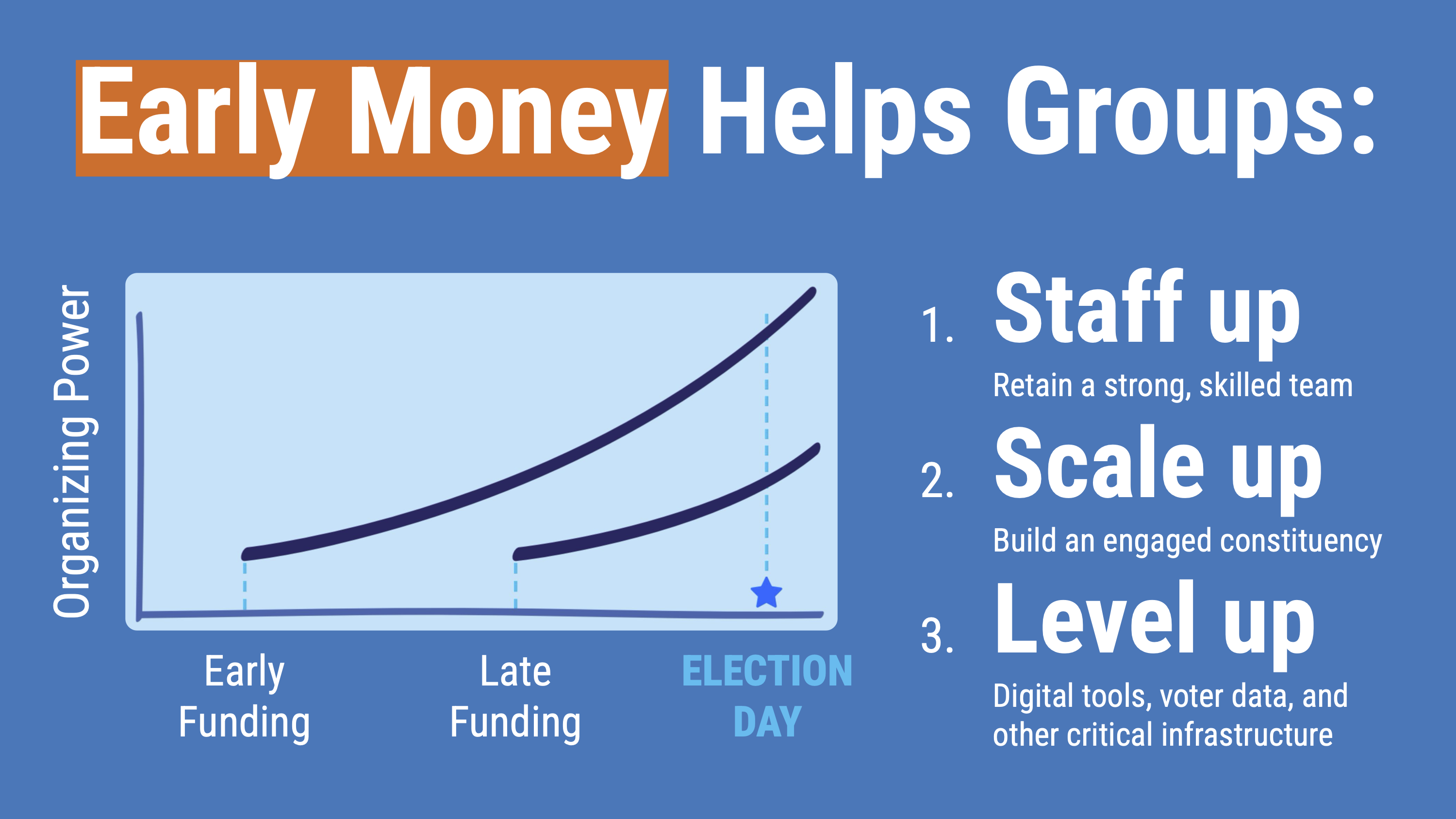
Every dollar today yields more votes than a dollar closer to Election Day.
Step 2: Give Early.
Every dollar we invest today yields way more votes than a dollar spent close to Election Day.
Think about Georgia. All those young voters and voters of color who swung the state in 2020, again in 2021, and again in 2022? Grassroots organizing did that, and it took over a decade of work — not just the mad dash in the last few months.
As Kendra Cotton, CEO of our local partner, New Georgia Project Action Fund, says:
“Winning in the odd years is just as important as winning in the even years—in fact, it’s what we do in years like 2019, 2021, and 2023 that makes our work so effective in 2020, 2022, and 2024.”
When we give early, grassroots groups are able to beat the “boom and bust” electoral funding cycle. In turn, this allows them to:
- Staff up: Retain skilled, experienced staff vs. hiring new staff months before the election.
- Scale up: Recruit leaders and build an engaged, galvanized, durable constituency.
- Level up: Build critical organizational infrastructure, from digital tools to voter data.
- Change policy: Frame the agenda, shift public opinion, and win tangible victories on key issues, thus giving people a reason to stay involved.
Giving Plan: The 50-25-25 Strategy
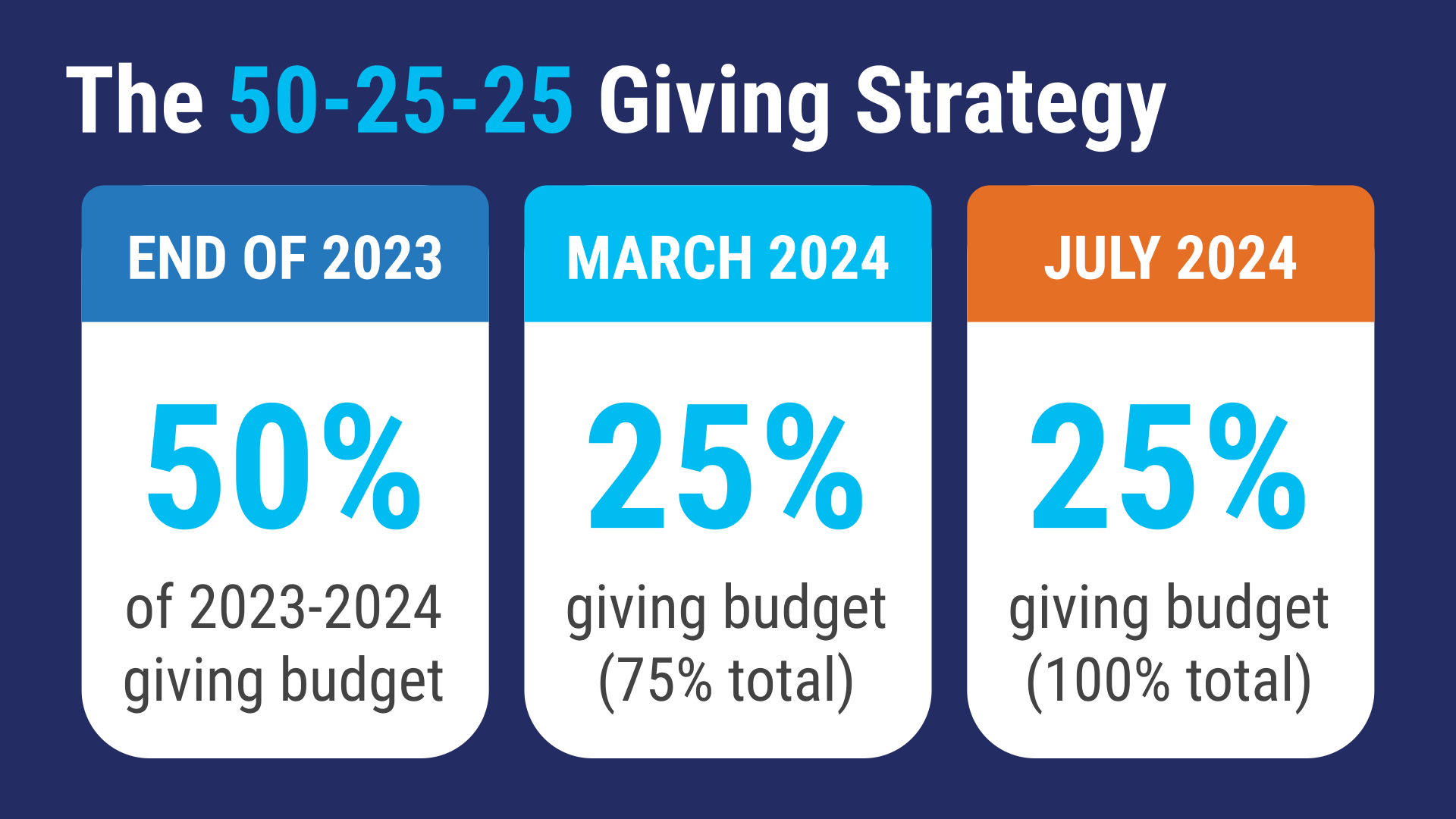
Here is a bold yet simple plan of action that takes away the guesswork:
- Set your 2023-2024 giving budget to support grassroots organizing. Dig deep. Then dig deeper. Identify the stretch you’d be proud to make.
- By end of 2023: Give 50% of your giving budget, as early as possible.
- By March 2024: Give the next 25%.
- By July 2024: Give the final 25%.
Simply giving earlier will make your money go a lot farther.
Besides maximizing your impact, there is a positive side benefit: You can hit “unsubscribe” on all those political fundraising emails clogging your inbox.
Step 3: Rally Your Network.
A question to “agitate” us, as we say in the organizing world:
What if donors organized other donors, so swing-state organizers had the funding to focus on organizing voters?
What if progressive donors embraced our full financial power and influence, by focusing our free time and energy on getting other people we know to donate?
Put another way, which is likely to turn out more votes if you have a free hour:
- A) Calling voters you’ve never met in a state where you don’t live? Or,
- B) Dropping notes to like-minded friends who you know are able to make a donation, believe in the cause, and are connected to the messenger (you)?
Each of us is a trusted messenger to someone.
To whom are you a trusted messenger?
215 People’s Alliance – Door-to-Door Canvass
Why I Trust the “Trusted Messengers”
Extensive research and aggregated results of hundreds of randomized control group experiments, as well as progressive campaigns’ and organizations’ experience, show that person-to-person “relational” outreach moves people to action.
The evidence shows that, not surprisingly, neglected voters are most likely to turn out when they hear from their friends, family, neighbors, faith leaders, and others they know and trust.
This is why swing-state grassroots organizations are the most effective “trusted messengers” to get out the vote in their own communities. Local organizations are ready to scale teams of door-knockers, dorm-stormers, relational organizers, and neighborhood voter organizers in the swing states and races that matter most. They just need the funding to scale up.
We Have Power in Community
As LaTosha Brown, co-founder of Black Voters Matter, put it:
“There’s always an infrastructure that exists in the community. We all know the sisters, the old ladies, who live on the street who know everything happening in their neighborhood. We know the corner store that you go to where you get information. We know the folks who, when somebody’s in trouble or their house is caught on fire, who is going to show up and provide resources for them. That’s the power in our community.”
I know it’s tempting to write postcards to voters, join a phonebank, or even get in the car or hop on a plane to knock on doors. It’s real, it’s tangible, and sometimes really fulfilling.
It’s definitely not “either/or”. For those who want to phonebank or door-knock, our national partner organization Seed the Vote excels at connecting volunteers to the groups (including many MVP local partners) that are able to take advantage of outside support.
But whether or not you choose to get out the vote, I want to challenge progressive donors this cycle to focus primarily on something that might feel uncomfortable: Talking with people about how to deploy money to make a strategic impact. If we don’t, who will?
Offering a Gift, Not Asking a Favor
Legendary fundraiser Lynne Twist once said:
“Money moving in the direction of our highest commitments nourishes our world and ourselves.”
When we invite someone to make a donation to what we believe is its highest best use, we’re not asking them to do something “for” us. We’re offering them a gift: The chance to align their money with their values and make sure it is deployed most effectively toward their own goals.
It doesn’t have to be hard or complex. You can have a house party, dinner party, or Zoom party. Or you can even just write a short note to your networks. Tell them why and why now. And invite them to join you. You never know how your note might get passed around or who your note might touch.
Closing: Let’s Win the Amazing Scenario!
Movement Voter PAC and so many of our progressive funding colleague organizations are here to help you turn money, time, and inspiration into the change you want to see. You don’t have to figure this out by yourself.
We Are the Ones We’ve Been Waiting For
The future of the world and everything we love depends on us being our most heroic selves. We don’t just need Batman. We need the whole Justice League. We need all the Avengers. We need Wonder Woman, Black Panther, and we need you standing side by side with all of us, playing your most heroic role.
14 months from now, we will end up in the scenario of our choice. If we choose the Amazing Scenario, we will have a much better country in two to four years. If we choose the Mediocre Scenario, we could have a much better country in 10-12 years. If we choose the other two scenarios (through our inaction), we may regret it for the rest of our lives.
These are not just words on a page. We truly do need you. If we can hold hands and jump together in the next 14 months, we have a fighting chance to make this country a better place.
2024 Opens the Door
If we do this right, 2024 opens the door to a world of possibility.
If we can stay committed and show up consistently over the next few election cycles, we can change this country and finally get over the hump of every election being “the most important of our lifetime.”
We can create a “new normal” where we reliably win federal elections by multiple percentage points, enact policies that reflect our values, and rebuild our country with a more sustainable and inclusive vision.
It may sound obvious, but winning electorally in 2024 is the key that unlocks the door to so many things. We can make our country a more just, free, and humane place. We can ameliorate the right-wing threat and stem its spread internationally. We can decarbonize the world economy and address the climate crisis in one generation.
We can create a legacy we are proud of on this Earth – for our children and our children’s children.
There really and truly is no time to waste.
So what do you want to do?
I propose that we do everything in our power to win the Amazing Scenario.
What’s stopping us?
Take a minute and think about what is stopping you.
Talk it over with whomever you need to talk it over with.
Let’s make it happen. Let’s go for it. Let’s do this.
Let’s leave a legacy we can be proud of.
What do you want to do?
This memo was authored by Billy Wimsatt and co-authored and edited by Zo Tobi; with major contributions by Laura Flynn, who conceived and drafted Act II; and with edits and feedback from Anna Grant, Andrea Catone, Lisa Beem, Mike Gast, Talya Stagg, Rachel Gordon, Rahna Epting, Anna Galland, Chloe Cockburn, Laura Livoti, Haley Bash, Betty Herschman, Jackie Kaplan-Pekins, Tom Mendelsohn, Jason Franklin, Sarah Chaisson-Warner, Javier Morillo, Carrie Cuthbert, Ulysses Lateiner, Margit Birge, Irene Yen, David Roitman, Kara Tennis, Diane Kemsley, Janet Selcer, Steve Miller, Dana Brooks, the MVP Eastern MA Hub Steering Committee, the Movement Voter PAC Team, and many other donors and friends, although Billy Wimsatt is solely responsible for the final product.
Supporter Resources
Make a Contribution
Donate today, and MVP will distribute funds to support the most effective groups and competitive races, based on constantly evolving on-the-ground knowledge and political analysis.
Printable PDFs
Here are the Full Memo & Executive Summary for download.
Press Clips & Mentions
- The New York Times: Where Has All the Left-Wing Money Gone? by Michelle Goldberg (pdf)
- The Guardian: US progressive groups facing ‘five-alarm fire’ ahead of 2024 as donations down by Edward Helmore (pdf)
- Blue Tent: Sending Up the Bat Signal (an abridged version of this memo)
- Chop Wood, Carry Water: September 21, 2023 edition by Jess Craven
- The Connector: The Poverty of Democratic Organizing Reaches a Crisis Point by Micah Sifry
- Innovation and Money in Politics: Sending up the Bat Signal to funders by David Slifka
Shareable Blurb
The Bat Signal Memo is an urgent call to action from Movement Voter PAC to progressive donors, to stop Trump and cause a massive “Blue Wave” in 2024 — by giving big and early to the grassroots organizing groups that can swing the most crucial races.
The 2024 elections will come down to a few votes in a few states, and the Bat Signal spells out why we need to take action now — not a year from now — to prevent the worst case scenario (a Trump / MAGA takeover of all three branches of government) and ensure the best scenario (a progressive landslide).
Here’s the memo:
https://movement.vote/batsignal?refcode=batsignal-share
Social Media Posts
Want posts emailed to your inbox?
Subscribe to our Substack:
